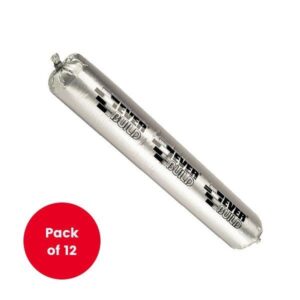What is a hybrid polymer sealant?
Developed for high performance in areas such as strength and handling, silane-curing organic hybrid polymers products combine the benefits of both polyurethanes (e.g. mechanical strength and paintability) and silicones (e.g. elasticity). Hybrid polymers can be processed easily and reliably, and are incredibly versatile.
The extremely low viscosity of hybrid polymer products means no additional solvents or plasticisers are required for these sealants and adhesives. It also makes these polymers easy to process and gives them unparalleled mechanical properties, as well as a wide formulation tolerance. Meanwhile the hybrid polymers’ fast curing rate allows them to harden rapidly without forming blisters and adhere to most common substrates without the need for a primer.
Hybrid polymer sealants applications
Favoured both for DIY and industrial applications, hybrid polymer products are great for construction joints and bonds, as well as more complex applications such as sports grounds and boats. These applications can vary from bonding of wood and parquet to lighting systems, cover strips and mirrors.
Some hybrid polymer sealants, like the Everbuild Hybriflex SMP, are specifically designed for multi-purpose floor and wall joint grade, all concrete saw cuts, cladding applications and slab expansion joints where abrasion resistance is required.
What is co-polymer sealant?
Co-polymer sealants are a type of sealant that’s highly versatile, flexible and waterproof. They offer a range of application benefits such as strong adhesion to damp, wet or oily non-porous surfaces, paintability and crystal clear curing which makes them virtually indistinguishable from their surroundings.
What is an MS polymer sealant?
The popularity of hybrid sealant products has recently grown dramatically, largely thanks to the fact that they can combine the strengths of multiple different polymeric materials, while also neutralising the downsides of each one.
Hybrid sealants can be split into two main groups: silyl-modified polyurethanes (or SPUR polymers) and silyl-modified polyethers (or MS polymers). The two polymer types share many chemical properties and are most commonly used in the building and construction industry as high-performance sealants.
Combining the weathering resistance typical for silicones with the strength of polyurethanes, hybrid sealant products like Everbuild Hybriflex 25LM provide unparalleled performance. Their formulation versatility, meanwhile, makes early strength development and viscosity customisation required for various applications possible.
MS sealant products are a particular favourite, since their balanced properties and versatility make them a hybrid polymer suitable for a myriad of applications. Classed as “high performance sealants” thanks to their great movement capability in construction joints, MS sealants offer some unique features compared to other sealant types.
These include excellent adhesion to most common substrates, including wood, metals, plastics and ceramics, as well as enhanced weather resistance. In fact, MS sealants show great durability when exposed to extreme climates, with no signs of diminished adhesion, cracks or discolouration. What’s more, since their viscosity is not as dependant on temperature changes as that of other sealants, MS polymers boast low temperature gunnability.
Unlike silicone sealants, MS sealants are stain resistant and easy to paint. They also form skin much faster than silicone and urethane adhesives, meaning they pick up considerably less dirt. Despite sharing many of their performance characteristics with urethane sealants, MS polymers cure much faster and in significantly deeper sections. This makes them the preferred option for industries such as construction, where the speed of property development is a priority.
Why hybrid sealant and adhesive products?
Urethanes, silicones and acrylics have until recently been the most commonly used types of sealants and adhesives. While good for insulating joints and gaps to keep water, air and debris out, traditional sealant products have a number of shortcomings. These include lack of long term flexibility and stability, shrinking and the formation of cracks due to UV exposure.
Hybrid sealants, such as the Everbuild Hybriflex 480, are the newest technology to emerge in the field. Combining the best features of urethane and silicone sealants, the high performing hybrid sealants are rapidly growing in popularity as the preferred method of adhesion in the industry. Thanks to their application versatility, hybrid sealants can be used for the same applications as other traditional sealants, and adhere to a range of porous materials and construction substrates including concrete, metal, plastic, stone, wood, gypsum and ceramics.
Due to being high in solid content, hybrid sealants are usually low in solvents, containing less than 10%. Since higher solvent content means the longevity of the adhesive is dramatically shortened, hybrid sealants are much less likely to dry out and fail than adhesives high on solvents.
The high solid content of hybrid sealants also means they are not prone to cracks or shrinking when exposed to UV radiation or extreme weather, meaning they offer buildings better, more durable protection against both air and moisture.
What’s more, the majority of hybrid sealants contain barely any trace of Volatile Organic Compounds (VOCs). This makes them perfect for applications in facilities such as offices, schools and hospitals where strong chemical odour is likely to cause disruptions.
Some of the more common applications of hybrid sealant includes chimneys, wood steps, window re-glazing, door thresholds and joints between façade panels, as well as filling expansion joints and adhering metal to masonry.

